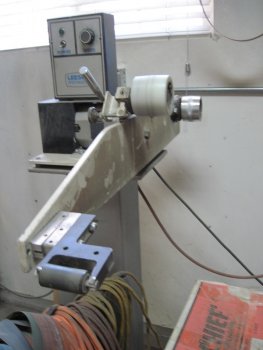I assume it's one with the "outboard" bearings? (bearings mounted outside/ends of wheel). I really wish the "old style" were still sold....those are the ones that had bearings inside the wheel. Most quit making them because the bearings wore out so quickly. The reason I like the internal bearings in a small wheel is that the bearings do not get in the way when using the wheel. With the outboard bearings, you can only "twist" what you're working on some much...for me that is usually working in the guard/handle junction of knives, before it hits those outboard bearings and stops any further progress. I initially built my own small wheel attachment, based off the old Wilton design, and the only place I can find small wheels with internal bearings is Bader. I also set mine up with a dummy roller for clearance it tight spots. Everybody is likely familiar with the "new" style....but here's a pic of the "old style" that I prefer, with the bearing set inside the wheel..... the big drawback is that these bearings MUST be run at slow speeds, and even then, for only about 10 mins MAX. On the up side, I can buy 10 replacement bearings for about $10, and they press in with finger pressure.


If you find yourself in a situation where the outboard bearings are getting in your way, the best thing to do is to "tear" yourself about 1/2" wide belt, and go to the slack belt method.



